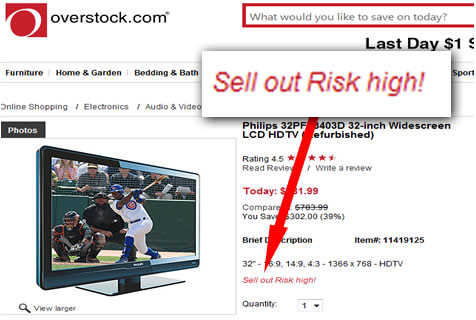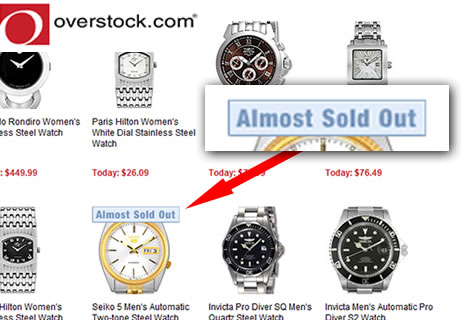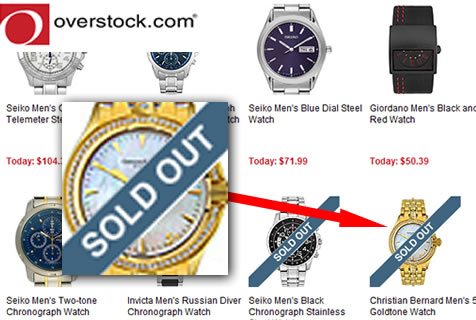Selling with Scarcity

Ecommerce websites have a great opportunity to exploit the “scarcity effect,” primarily because they can often provide instantaneous feedback on inventory levels and, in a credible way, let customers know when products are scarce.
First, let’s look at a traditional exploitation of the scarcity effect. Knife Outlet uses two scarcity variables, invoking both “limited quantities” and, for good measure, an expiration date. In conjunction with bold, red product prices, not a bad job. Nevertheless, this doesn’t really go beyond what could be accomplished in printed material. To be even more potent, specific details will increase the credibility of the scarcity ploy:

Amazon knows a few things about ecommerce, and they warn consumers when stock is running low. Combine the scarcity effect with, say, one-click ordering and free shipping, and you’ve got a powerful tool for getting visitors to click the “buy” button.

Travel is another area that seems to foster indecision. There are often a plethora of flight choices – dates, times, airports, connections, intermediate cities, etc. I know I often have multiple windows open from different travel sites, in each case trying to find the perfect combination of price and convenience. What’s one way to get people to stop dithering? Tell them they might miss their chance to book a flight because the seats are almost gone. Expedia does this, and more than once it was enough to get me to go ahead and book the flight then and there.
Overstock.com – The Scarcity Trifecta
Check out the various ways in which Overstock uses the scarcity effect. First, they offer a fairly generic warning of low stock on an item. No quantities, but a “sellout” alert:

That may be fairly prosaic, but Overstock.com goes a step farther by providing an alert on their search results page:

I think there’s little doubt that the viewer’s eye would be drawn to that flagged item. But, to complete the scarcity trifect, Overstock has one more card to play: they keep sold-out items in their results and flag them as “Sold Out.”

Some might find that a risky move – showing a customer an unavailable but interesting product might cause them to try to find it elsewhere. Or, a customer might decide to buy nothing at all if an interesting product was sold out. Nevertheless, these “Sold Out” indicators add credibility to the other scarcity warnings and add a sense of urgency to the shopping process.
The best way to imply scarcity in a credible way is to be specific. Tell visitors to the site how many you have left if you can do that. “Only two left at this price” is better than “limited supply.” If the volume of your offering is such that your inventory changes often, a dynamic display of scarcity would be even better. I think a really effective message would be something like, “Just sold another! Only one left!”
That may not work for every ecommerce site, but just about all can boost sales using at least one variation of the scarcity effect.
